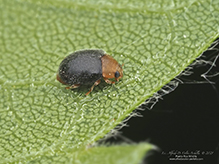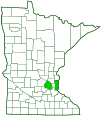Kansas lady beetle
(Scymnus kansanus)
Conservation • Description • Habitat • Ecology • Distribution • Taxonomy
Conservation Status |
|
|||||||
| IUCN Red List | not listed |
|||||||
| NatureServe | not listed |
|||||||
| Minnesota | not listed |
|||||||
Description |
||
Kansas lady beetle is a very small dusky lady beetle. There are few scattered records of this species, probably due more to its small size than to its rarity. It has been reported in New York, New Jersey, Tennessee, Indiana, Wisconsin, Minnesota, and Kansas. In 2008 it was reported for the first time in South Dakota. It has also been reported in southern Quebec and Ontario Canada. There are eight observations reported from Minnesota, all of them in 2021. The larvae feed on soft scale insects and aphids. Adults are found from mid-May through early September. Adults are small, 1⁄16″ (1.8 to 2.2 mm) in length. The body is thickly covered with bristly hairs (setose). It is somewhat elongated when viewed from above, and it is hemispherical when viewed from the side. The head is deeply inserted into the thorax, but it is visible from above. The eyes are large and are separated by two times their width. The antennae are short and have 10 or 11 segments. The first two segments are not enlarged. The last three segments are slightly expanded, forming a club. The two segments at the base of the club are uneven at the lower margins. The upper thoracic plate (pronotum) is convex and wider than long. It is rounded in front, and there is a broad, deep notch on the rear margin. It is entirely reddish yellow with no black markings. It is narrower at the rear than the hardened wing covers (elytra). The elytra are elongated oval, parallel sided in the middle. They are entirely black except for a narrow, reddish-yellow, rear margin. The legs are yellowish-brown. The last part of each leg (tarsus), corresponding to the foot, has four segments, but the third segment is very short and tucked within the extended lobes of the second segment, making the leg appear to have only three segments. The tip of the last tarsal segment on the middle and hind legs has a pair of claws. Each claw has a large tooth at the base. On the male, the inner claw is larger than the outer claw. |
||
Size |
||
Total length: 1⁄16″ (1.8 to 2.2 mm) |
||
Similar Species |
||
Habitat |
||
|
||
Ecology |
||
Season |
||
Mid-May through early September |
||
Behavior |
||
|
||
Life Cycle |
||
|
||
Larva Food |
||
|
||
Adult Food |
||
Soft scale insects and aphids |
||
Distribution |
||||
|
Sources |
|||
| 12/29/2023 | ||||
Occurrence |
||||
Uncommon? |
||||
Taxonomy |
|||
Order |
Coleoptera (Beetles) | ||
Suborder |
Polyphaga (Water, Rove, Scarab, Long-horned, Leaf, and Snout Beetles) | ||
Infraorder |
Cucujiformia | ||
Superfamily |
Coccinelloidea (lady, fungus, scavenger, and bark beetles) | ||
Family |
Coccinellidae (lady beetles) | ||
Subfamily |
Scymninae | ||
Tribe |
Scymnini (dusky lady beetles) | ||
Genus |
Scymnus | ||
Synonyms |
|||
|
|||
Common Names |
|||
Kansas lady beetle |
|||
Glossary
Elytra
The hardened or leathery forewings of beetles used to protect the fragile hindwings, which are used for flying. Singular: elytron.
Pronotum
The exoskeletal plate on the upper side of the first segment of the thorax of an insect.
Seta
A stiff, hair-like process on the outer surface of an organism. In Lepidoptera: A usually rigid bristle- or hair-like outgrowth used to sense touch. In mosses: The stalk supporting a spore-bearing capsule and supplying it with nutrients. Plural: setae. Adjective: setose.
Tarsus
On insects, the last two to five subdivisions of the leg, attached to the tibia; the foot. On spiders, the last segment of the leg. Plural: tarsi.
Visitor Photos |
|||||
Share your photo of this insect. |
|||||
| This button not working for you? Simply email us at info@MinnesotaSeasons.com. Attach one or more photos and, if you like, a caption. |
|||||
Alfredo Colon |
|||||
 |
|||||
MinnesotaSeasons.com Photos |
|||||
|
|||||

Slideshows |
||

Visitor Videos |
|||
Share your video of this insect. |
|||
| This button not working for you? Simply email us at info@MinnesotaSeasons.com. Attach a video, a YouTube link, or a cloud storage link. |
|||
Other Videos |
|||

Created: 12/29/2023
Last Updated:


